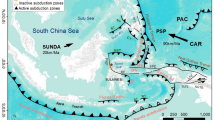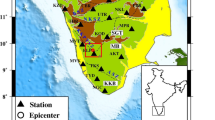Abstract
We calculated the crustal stress field using the composite focal mechanism method based on the P-wave initial motion polarity data of the Tengchong volcanic area from January 2011 to April 2019 obtained from the Bulletin of Seismological Observations of Chinese stations. The magnitude range of earthquakes used in this study is 0–4, and their magnitudes are mainly approximately 1.0. To investigate the influence of the source location on the stress field and obtain reliable stress fields of the study area, we applied the double-difference algorithm to relocate the seismic events, obtaining more accurate and reliable relative positions of seismic events with a clearer seismic belt. On the basis of relocation results, the study on the stress field along the fault zone was conducted, and the influence of seismic event position on the stress field was analyzed. Results show that, first, the current stress regime in the shallow crust of the Tengchong volcanic area is strike-slip faulting, the orientation of the principal compressive stress axis is NE-SW, the orientation of the principal extension stress axis is SE-NW, the principal compressive and extension stress axes are nearly horizontal, and the dip angle of intermediate principal stress axis is relatively large. This reflects that the volcanic and seismic activities in the Tengchong volcanic area are mainly controlled by the collision and squeezing effect of the Indian-Eurasian plate. It also reflects that the current tensile action caused by deep magma activity has little influence on the shallow crustal stress field. Second, the stress field along fault zones reveals that there exist local stress fields, such as the thrust stress regime at the strike-slip fault terminal area, which is consistent with the compressional area at the intersection of conjugate strike-slip faults indicated by previous study. Third, the stress field results are consistent, regardless of using the original location in the bulletin or the relocated location, indicating that the influence of the event location error can be neglected when there are sufficient data and reflecting the stability of the composite focal mechanism method. The findings can serve as a reference for investigating geological structure movement, seismic activities, and volcanic activities in the Tengchong volcanic area.
Similar content being viewed by others
References
Aki, K., 1966, Earthquake generating stress in Japan for the years 1961 to 1963 obtained by smoothing the first motion radiation patterns: Bulletin of the Earthquake Research Institute, 44(2), 447–471.
Andikagumi, H., Macpherson, C. G., and McCaffrey, K. J. W., 2020, Upper plate stress controls the distribution of Mariana Arc volcanoes: Journal of Geophysical Research: Solid Earth, 125, e2019JB017391.
Cocina, O., Neri, G., Privitera, E., et al., 1997, Stress tensor computations in the Mount Etna area (Southern Italy) and tectonic implications: Journal of Geodynamics, 23(2), 109–127.
Currenti, G., and Williams, C., 2014, Numerical modeling of deformation and stress fields around a magma chamber: Constraints on failure conditions and rheology: Physics of the Earth and Planetary Interiors, 226, 14–27.
Geyer, A., Marti, J., and Villaseñor, A., 2016, Firstorder estimate of the Canary Islands plate-scale stress field: Implications for volcanic hazard assessment: Tectonophysics, 679, 125–139.
Hardebeck, J. L., and Okada, T., 2018, Temporal stress changes caused by earthquakes: a review: Journal of Geophysical Research, 123, 1350–1365.
Heidbach, O., Rajabib, M., Cui, X. F., et al., 2018, The World Stress Map database release 2016: Crustal stress pattern across scales: Tectonophysics, 744, 484–498.
Hu, H. X., Lu, H. X., Wang, C. Y., et al., 1986, Explosion investigation of the crustal structure in Western Yunnan province: Chinese Journal of Geophysics, (in Chinese), 29(2), 133–144.
Hu, X. P., 2018, Crustal stress pattern across different scales in China: PhD Thesis, University of Science and Technology of China, Hefei (in Chinese).
Hu, X. P., and Cui, X. F., 2013, Study on earthquake relocation and tectonic stress field in Central North China: Techology for Earthquake Disaster Prevention, (in Chinese), 8(4), 351–360.
Jiang, C. S., Wang, S. J., Ye, J. Q., et al., 2005, Focal mechanism feature of small shocks in the Tengchong volcanis area: Journal of Seismology Research, (in Chinese), 28(2), 141–143.
Koenig, E., and Pollard, D., 1998, Mapping and modeling of radial fracture patterns on Venus: Journal of Geophysical Research, 103, 15183–15202.
Li, X. L., Xu, Y., and Wang, S., 2017, Evidence of magma activity from S-wave velocity structure of the Tengchong volcanic area: Chinese Science Bulletin, (in Chinese), 62(26), 3067–3077.
Marti, J., and Geyer, A., 2009, Central vs flank eruptions at Teide-Pico Viejo twin stratovolcanoes (Tenerife, Canary Islands): Journal of Volcanology and Geothermal Research, 181, 47–60.
Martínez-Garzón, P., Heidbach, O., and Bohnhoff, M., 2020, Contemporary stress and strain field in the Mediterranean from stress inversion of focal mechanisms and GPS data: Tectonophysics, 774, 228286.
Massaro, S., Sulpizio, R., Norini, G., et al., 2020, Modelling stress field conditions of the Colima Volcanic Complex (Mexico) integrating FEM simulations and geological data: Solid Earth, 11, 2515–2533.
Mériaux, C., and Lister, J. R., 2002, Calculation of dike trajectories from volcanic centers: Journal of Geophysical Research, 107(B4), 2077.
Michelini, A., and Lomax, A., 2004, The effect of velocity structure errors on double-difference earthquake location: Geophysical Research Letters, 31(9), 1–4.
Muller, O. H., and Pollard, D. D., 1977, The stress state near Spanish Peaks, Coloradode-termined from a dike pattern: Pure and Applied Geophysics, 115, 69–86.
Odé, H., 1957, Mechanical analysis of the dike pattern of the Spanish peaks area, Colorado: Geological Society of America Bulletin, 68(5), 567–576.
Pu, H. C., Lin, C. H., Hsu, Y. J., et al., 2019, Volcano-hydrothermal inflation revealed through spatial variation in stress field in Tatun Volcano Group, Northern Taiwan: Journal of Volcanology and Geothermal Research, 390, 106712.
Rivalta, E., Corbi, F., Passarelli, L., et al., 2019, Stress inversions to forecast magma pathways and eruptive vent location: Science Advances, 5(7), eaau9784.
Roman, A., and Jaupart, C., 2014, The impact of a volcanic edifice on intrusive and eruptive activity: Earth and Planetary Science Letters, 408, 1–8.
Sánchez, J. J., Wyss, M., and Mcnutt, S. R., 2004, Temporal-spatial variations of stress at Redoubt volcano, Alaska, inferred from inversion of fault plane solutions: Journal of Volcanology and Geothermal Research, 130, 1–30.
Shen, Z. K., Lü, J. N., Wang, M., et al., 2005, Contemporary crustal deformation around the southeast borderland of the Tibetan Plateau: Journal of Geophysical Research: Solid Earth, 110(B11409), 1–17.
Sheng, S. Z., and Meng, L. S., 2020, Stress field variation during the 2019 Ridgecrest earthquake sequence: Geophysical Research Letters, 47, e2020GL087722.
Sheng, S. Z., Wan, Y. G., Huang, J. C., et al., 2015, Present tectonic stress field in the Circum-Ordos region deduced from composite focal mechanism method: Chinese Journal of Geophysics, (in Chinese), 58(2), 436–452.
Spassov, E., 1998, The stress field in Australia from composite fault plane solutions of the strongest earthquakes in the continent: Journal of Seismology, 2(2), 173–178.
Tian, J. H., Luo, Y., and Zhao, L., 2019, Regional stress field in Yunnan revealed by the focal mechanisms of moderate and small earthquakes: Earth and Planetary Physics, 3(3), 243–252.
Waldhauser, F., and Ellsworth, W., 2000, A double-difference earthquake location algorithm: method and application to the Northern Hayward Fault, California: Bulletin of the Seismological Society of America, 90(6), 1353–1368.
Wan, Y. G., 2010, Contemporary tectonic stress field in China: Earthquake Science, 23(4), 377–386.
Wan, Y. G., Wu, Y. M., Sheng, S. Z., et al., 2011, Priliminary result of Taiwan 3-D stress field from P wave polarity data: Chinese Journal of Geophysics, (in Chinese), 54(11), 2809–2818.
Wang, C. Y., Huangfu, G., Wan, D. B., et al., 2000, Deep seismic sounding of crustal structure in Tengchong volcanis area: Journal of Seismological Research, (in Chinese), 23(2), 148–156.
Wang, S. J., and Long, X. F., 2000, Study on tectonic stress field in Tengchong volcano areas: Journal of Seismological Research, (in Chinese), 23(2), 172–178.
Wyss, M., Liang, B. Y., Tanigawa, W. R., et al., 1992, Comparison of orientations of stress and strain tensors based on fault plane solutions in Kaoiki, Hawaii: Journal of Geophysical Research, 97(B4), 4769–4790.
Xu, Z. G., Huang, Z. C., Wang, L. S., et al., 2016, Crustal stress field in Yunnan: Implications for crust-mantle coupling: Earthquake Science, 29(2), 105–115.
Xu, Z. H., Wang, S. Y., Huang, Y. R., et al., 1992, Tectonic stress field of China inferred from a large number of small earthquakes: Journal of Geophysical Research, 97, 11867–11877.
Xu, Z. H., Liu, Y. F., Zhang, Y. Z., et al., 1979, On the characteristic of direction of the earthquake stress field around the Beijing area: Acta Seismologica Sinica, (in Chinese), 1(2), 121–132.
Xue, H. Y., and Yan, J. Q., 1984, The contemporary crustal stress field around the Ordos block: Chinese Journal of Geophysics, (in Chinese), 27(2), 144–152.
Zhang, G. W., and Lei, J. S., 2015, Mechanism of the 2011 Tengchong, Yunnan, MS5.2 double earthquakes: Chinese Journal of Geophysics, (in Chinese), 58(4), 1194–1204.
Zhao, X. Y., Han, L. B., Long, F., et al., 2012, Focal mechanism solutions and seismogenic structures of Yingjiang Ms≥4.0 earthquake sequences in 2011: Journal of Seismological Research, (in Chinese), 35(4), 477–484.
Zhao, L., Luo, Y., Liu, T. Y., et al., 2013, Earthquake focal mechanisms in Yunnan and their inference on the regional stress field: Bulletin of the Seismological Society of America, 103(4), 2498–2507.
Zoback, M. L., 1992, First- and second-order patterns of stress in the lithosphere: the world stress map project: Journal of Geophysical Research, 97(B8), 11703–11728.
Acknowledgments
The author would like to thank the National Scholarship Fund, the National Natural Science Foundation of China (Nos.41704053, 42174074, 41674055), and the East China University of Technology Research Foundation for Advanced Talents (ECUT) (DHBK2019084) for financial support. We thank the China Seismological Network Center (CENC) for providing the observation report. We also appreciated the valuable help from the Associate Research Fellow of Xin Hai-liang, Xu Zhi-guo, and Wang Wei-lai.
Author information
Authors and Affiliations
Corresponding author
Additional information
Sheng Shu-Zhong, associate professor, graduated from Anhui University in 2005 with a Bachelor of Science degree in physics. In 2008 and 2016, he obtained Master of Engineering and Doctor of Science degrees from the Institute of Geophysics, China Earthquake Administration, respectively. From 2008 to 2018, he worked as an associate professor in the Institute of Disaster Prevention and currently works at East China University of Technology. He is mainly engaged in the research of tectonic stress field and seismicity triggering.
Rights and permissions
About this article
Cite this article
Sheng, Sz., Wan, Yg., Jiang, Cs. et al. Study on the crustal stress field of the Tengchong volcanic area using composite focal mechanism method. Appl. Geophys. 18, 239–252 (2021). https://doi.org/10.1007/s11770-021-0897-z
Received:
Revised:
Published:
Issue Date:
DOI: https://doi.org/10.1007/s11770-021-0897-z




